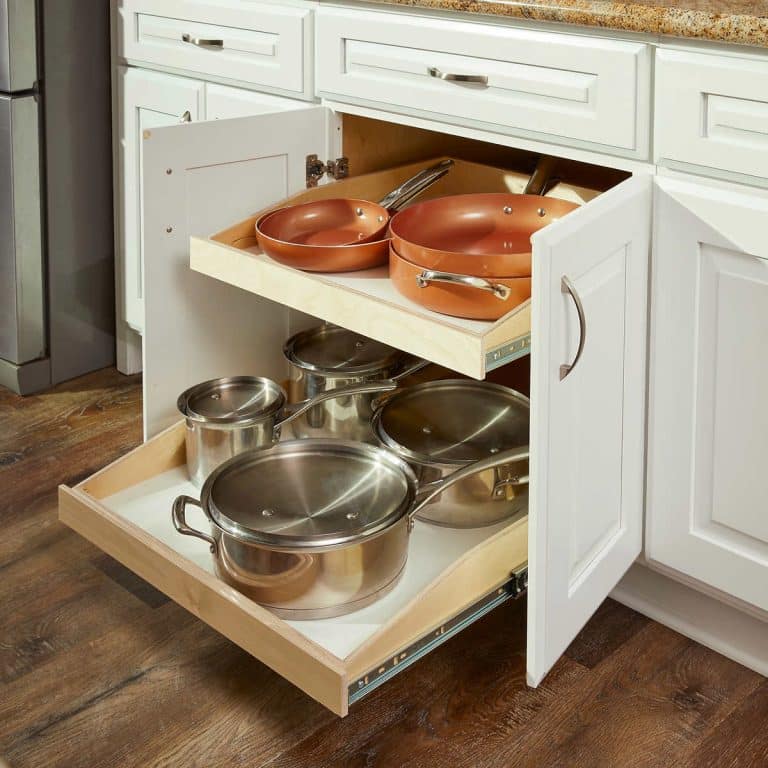Understanding Wood Roll Out Cabinet Shelves

Wood roll-out cabinet shelves are a practical and stylish upgrade to traditional fixed shelves. They provide easy access to items stored in cabinets, enhancing convenience and organization.
Types of Wood Used for Cabinet Shelves
The type of wood used for cabinet shelves influences their durability, aesthetics, and cost.
- Hardwoods: Hardwoods, such as oak, maple, and cherry, are known for their strength, durability, and beautiful grain patterns. They are typically more expensive than softwoods but offer excellent longevity and resistance to scratches and dents.
- Softwoods: Softwoods, such as pine and fir, are lighter and more affordable than hardwoods. They are suitable for less demanding applications and can be easily stained or painted to match cabinet finishes. However, they are less resistant to scratches and dents.
- Engineered Wood: Engineered wood products, such as plywood and medium-density fiberboard (MDF), are made from wood veneers or fibers bonded together with adhesives. They offer affordability and consistent quality. While they may not have the same natural beauty as solid wood, they are durable and readily available in various thicknesses and finishes.
Roll-Out Mechanisms for Cabinet Shelves
Roll-out mechanisms for cabinet shelves vary in their functionality and ease of use.
- Full Extension Slides: Full extension slides allow the shelf to extend completely out of the cabinet, providing easy access to items stored at the back. These slides are ideal for heavy items or those requiring frequent access.
- Partial Extension Slides: Partial extension slides allow the shelf to extend partially out of the cabinet, providing access to items in the front. These slides are suitable for lighter items or those accessed less frequently.
- Soft-Close Slides: Soft-close slides incorporate a mechanism that slows the shelf’s movement as it retracts, preventing slamming and noise. These slides are particularly useful in kitchens and bathrooms where quiet operation is desired.
Installation and Customization

Installing wood roll-out cabinet shelves involves a straightforward process, but it is essential to ensure proper measurements and preparation for a seamless installation. This section provides step-by-step instructions for installing wood roll-out shelves and offers insights into customizing them to meet specific storage needs and aesthetic preferences.
Installation
Installing wood roll-out shelves requires careful planning and precise measurements to ensure a smooth and functional installation. The following steps Artikel the installation process:
- Measure and mark the installation area: Determine the exact dimensions of the cabinet space where the roll-out shelves will be installed. Measure the width, depth, and height of the area, taking into account any existing fixtures or obstructions. Mark the installation points on the cabinet walls or base using a pencil or marker.
- Prepare the installation area: If necessary, remove any existing shelves or obstructions from the designated area. Ensure the surface is clean and free of debris. If the cabinet walls are not level, use a level and shims to ensure proper alignment for the roll-out shelves.
- Install the mounting brackets: Attach the mounting brackets to the cabinet walls or base according to the manufacturer’s instructions. Use screws or other fasteners appropriate for the cabinet material. Ensure the brackets are securely fastened and level to support the weight of the roll-out shelves.
- Install the roll-out shelf assembly: Carefully slide the roll-out shelf assembly into the mounting brackets. Ensure the assembly slides smoothly and aligns correctly. If necessary, adjust the mounting brackets or the shelf assembly to ensure proper alignment.
- Secure the roll-out shelf assembly: Once the roll-out shelf assembly is in place, secure it to the mounting brackets using the provided fasteners. Ensure the shelf assembly is securely fastened to prevent movement or instability.
- Test the roll-out shelves: After installation, test the roll-out shelves by extending and retracting them. Ensure they move smoothly and do not bind or stick. Adjust the shelf assembly or mounting brackets if necessary to ensure proper operation.
Customization
Customizing wood roll-out shelves allows for a personalized storage solution that complements existing décor and meets specific storage needs. Here are some customization options:
- Finishing: Apply a stain or paint to match the existing cabinet finishes or create a new aesthetic. Choose a finish that is durable and resistant to moisture and wear.
- Hardware: Select handles or knobs that complement the cabinet style or add a unique touch. Choose hardware that is functional and easy to use.
- Dividers and organizers: Install dividers or organizers to create separate compartments within the roll-out shelves. This helps to maximize storage space and keep items organized.
- Custom dimensions: If the standard sizes do not meet specific needs, consider custom-made roll-out shelves. A skilled carpenter can create shelves with unique dimensions to fit the exact requirements.
Shelf Configurations and Ideal Uses
The configuration of wood roll-out shelves significantly impacts their functionality and storage capabilities. Here is a table showcasing different configurations and their ideal uses:
| Configuration | Ideal Uses |
|---|---|
| Single-tier roll-out shelf | Storing large items, such as pots and pans, baking sheets, or platters |
| Two-tier roll-out shelf | Storing a variety of items, such as plates, bowls, or utensils |
| Three-tier roll-out shelf | Storing smaller items, such as spices, canned goods, or snacks |
| Pull-out drawer with dividers | Organizing utensils, cutlery, or other small items |
Maintenance and Care

Proper maintenance and care are crucial for extending the lifespan of wood roll-out cabinet shelves and ensuring their smooth operation. Neglecting these aspects can lead to wear and tear, compromising their functionality and aesthetics.
Cleaning and Maintaining Wood Roll-Out Cabinet Shelves
Regular cleaning is essential for maintaining the appearance and functionality of wood roll-out cabinet shelves. Dust, food spills, and other debris can accumulate on the shelves, affecting their smooth operation and potentially damaging the wood.
- Dusting: Regularly dust the shelves using a soft cloth or a feather duster. Avoid using abrasive cleaning materials that can scratch the wood surface.
- Spot Cleaning: For spills or stains, use a damp cloth with mild soap and water. Avoid using harsh chemicals or abrasive cleaners that can damage the finish.
- Polishing: Periodically apply a wood polish or wax to protect the wood and enhance its shine. Choose a polish suitable for the type of wood used in the shelves.
- Drying: After cleaning, ensure the shelves are completely dry before placing items back on them. Moisture can damage the wood and lead to warping or mold growth.
Common Problems and Solutions
Several issues can arise with wood roll-out cabinet shelves, requiring prompt attention to prevent further damage. Understanding these problems and their solutions can help you maintain the shelves effectively.
- Sticking or Squeaking: If the shelves stick or squeak, it could be due to dust, debris, or dried-out lubricant. Clean the tracks and rollers thoroughly, and apply a light lubricant, such as silicone spray, to the rollers and tracks. Avoid using oil-based lubricants, as they can attract dust and grime.
- Sagging Shelves: Overloading the shelves can cause them to sag. Distribute the weight evenly and avoid placing heavy items on the edges. If sagging persists, consider replacing the shelves with thicker or reinforced ones.
- Loose Hardware: Over time, screws and other hardware can loosen, causing instability. Check the screws and tighten them as needed. If the screws are stripped, replace them with new ones of appropriate size and material.
- Damaged Finish: Scratches or chips in the finish can expose the wood to damage. Touch up minor scratches or chips with a wood filler or marker matching the original finish. For significant damage, consider refinishing the shelves.
Regular Inspection and Maintenance Checklist, Wood roll out cabinet shelves
Implementing a regular inspection and maintenance routine can help identify potential issues early and prevent them from escalating.
- Visual Inspection: Regularly inspect the shelves for any signs of damage, such as scratches, chips, or cracks. Check for loose screws or other hardware.
- Functionality Check: Test the smooth operation of the rollers and tracks. Ensure the shelves slide in and out effortlessly without sticking or squeaking.
- Cleaning: Dust and clean the shelves regularly using appropriate cleaning methods. Avoid harsh chemicals or abrasive cleaners.
- Lubrication: Apply a light lubricant to the rollers and tracks as needed to ensure smooth operation.
- Weight Distribution: Avoid overloading the shelves and distribute the weight evenly to prevent sagging.
Wood roll out cabinet shelves are a fantastic way to maximize storage space in any room, especially a bedroom. If you’re looking for inspiration on how to create a calming and stylish bedroom, you might find some great ideas by browsing grey and blue bedroom images.
These color palettes often create a serene atmosphere, and you can incorporate the same soothing tones into your cabinet design for a cohesive look.
Wood roll out cabinet shelves are a fantastic way to maximize storage space and make accessing your kitchen essentials a breeze. However, to keep these shelves looking their best, regular cleaning is essential. A gentle and effective cleaning solution is cleaning wood cabinets with Murphy Oil Soap , which can help remove dust and grime while nourishing the wood.
With proper care, your wood roll out cabinet shelves will remain beautiful and functional for years to come.
